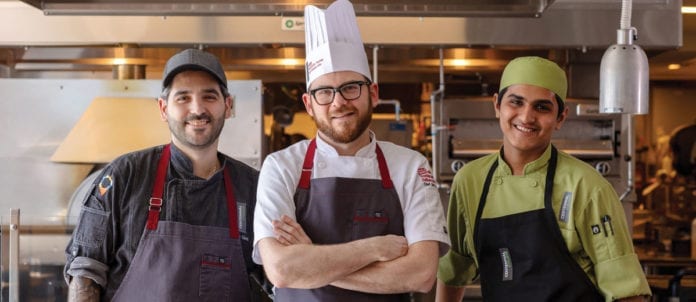In the escalating fight for talent and patrons, the choice of uniforms is becoming a major selling point for many operations.
So, when a foodservice establishment gets a chance to start from scratch, it’s the perfect opportunity to pull out all the stops and create something that will outshine competitors.
Uniforms are something that Joe Baker, dean, School of Hospitality, Tourism and Culinary Arts at Centennial College says the school has taken to heart. Centennial recently launched a major uniform program to match its five-year physical transformation at the school.
“We realized we’re working with a generation that values a unique identity; that doesn’t want to fit with the conventions of the past,” Baker explains. “They want to be creative and expressive. It’s important for us to have the flexibility to understand their needs so they can feel good about themselves and their organization.”
The school has three distinct uniform designs for the chefs, students and restaurant staff. For the chefs, they opted to go with MEE-CHef, a Toronto-based supplier known for its unique, customized designs.
The custom-fitted jackets buck tradition in a number of ways. For example, logos are moved from the front to the left sleeve so they’re always visible. Rather than using first and last names, the embroidery I.D. is on a first-name basis. “We wanted to make them appear more approachable and informal,” Baker says.
All jackets are short sleeved, he adds. “It allows some of them to show off their body art. It’s all about giving them the ability to express themselves.”
The jacket backs also feature a high-tech mesh material used for astronauts and athletes to keep body temperatures cooler and there’s a loop at the back with a snap that attaches the apron to keep them from slipping. Topping off the jackets are custom-designed gray bib aprons with burgundy straps.
Student chef jackets and hats from Chef Works in Richmond Hill, Ont. are green — one of the school’s brand colours. “It makes them feel proud and represents our values and focus on sustainability,” Baker explains. “That really resonates with the students. The colour also makes them stand out during competitions.”
Last, but not least, the restaurant culinary team is kitted out with denim chef jackets and ball caps, with the same aprons as faculty members. “They look cool, which is important to them.”
byPeterandPauls.com in Toronto had the opportunity to create a new uniform program with the opening of its new Petros 82 contemporary Mediterranean-style restaurant in Toronto’s Hotel X. When the time came to choose uniforms, the company worked with Chef Works. “We wanted them to be upbeat and professional, but we also wanted the look to be unique and fresh,” says Anna Neri, vice-president, Branding.
Wait staff wear freshly pressed white or black chef jackets and black bib aprons. Aprons will feature a giant, white number one, two or three on the front. “It’s a conversation piece that makes them more approachable,” Neri notes. They also serve a practical purpose: number one identifies the server, two the busboy and three the runner.
“The aprons balance out the formality of the jacket, making it all a bit hipper and more current,” she says. “They also get to wear really cool Vans high-top shoes.”
As a company that manages several venues, Neri says it has plenty of experience figuring out what works and what doesn’t when choosing uniforms. “You have to make sure that what you get is wash-and-wear and of decent quality at the right price.”
She’s also learned a few cost-saving tips. For example, customizing with embroidery allows restaurants to personalize designs without running into high costs. “It’s a great way to flip a traditional piece like a chef jacket and add some personality.”
For Jacques Gaspo, co-owner of Foodtastic in Montreal and a trained clothing designer, uniform design is all about staying ahead of the curve. “When everybody does the same thing, I know it’s time to do something different,” he says.
When Gaspo tried to source chef’s aprons for Souvlaki Bar 10 years ago, it was hard to find what he wanted. “It’s an idea that started with hair salons. But, when we came up with it, there were no suppliers. Now it’s a big trend and every supplier has them.”
At La Belle & la Boeuf Burger Bar, servers wear simple jeans and t-shirts, while bartenders wear more formal jackets, ties and shirts. “It’s a hipster look reminiscent of a fancy hotel in the 1920s.”
Gaspos next project will be consulting on uniform designs for Miss Wong, a new Chinese restaurant in Montreal. Gaspo will be working with colourful satins and designs inspired by James-Bond-era movies.
Whatever the theme, there are several important principles that drive all his decisions. “I’ve always been against promoting sexuality in clothing,” says Gaspo. “We’re firm believers in professionalism and honouring the power of women. That’s important to recognize in this business.”
Another is local sourcing and sustainability. Gaspo has spent years seeking out suppliers of environmentally friendly textiles made from sustainable materials.
Staying on trend is no easy task for a company managing multiple franchise concepts. “There’s a lot of cost you have to put into it.”
But he also understands that when people come to work, they need to feel part of the concept. “If you can’t do that, they might quit.”
Written by Denise Deveau


















